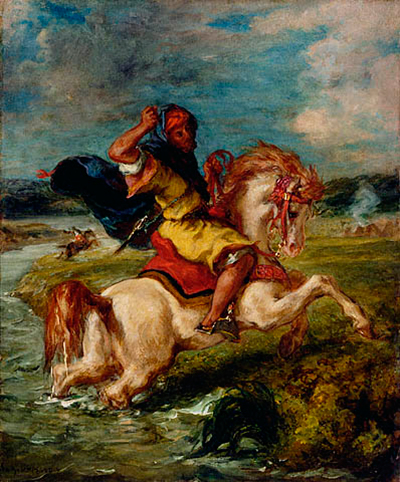This painting is dated to around 1850. It is typical of Delacroix's Romanticist approach, as well as his extended focus on the Moroccan culture. He was a master of multiple genres, often combining them together within the same composition as found in front of us here.
Movement became a key part of the artist's oeuvre, and in this example we find a horseman struggling through a river on horseback. He raises his fist in the air as the strong animal manages to climb out of the water. The pose is triumphant, with man and animal seemingly in perfect harmony. Delacroix loved depicting animals and studied them for many years in order to capture their intricate details as accurately as possible. This painting is noticeably dim in light, though the image displayed here may not quite get that across. The artist liked to darken his scene many times in order to make the atmosphere in each a little more dramatic. We can also see in the background of this painting another horseman, with the artist creating a feeling of loneliness for these soldiers as they make their way back to camp across wide expanses of land.
The artist would produce many artworks based in Morocco across his career, as well as other items that were based closely on elements of the nation's culture. Other notable paintings to look out for include Moroccan Fantasia and Moroccan Saddling a Horse, to name just two. European painters would start to look for other cultures to inspire their work, with a variety of regions coming under their focus. There was the work of Gerome, for example, who became very interested in Islamic culture. Later on, many of the Impressionists and Post-Impressionists would then collect Japanese art, and sometimes would make copies of them for their own collections. African art would also feature with masks and sculpture, as different influences started to come in via the trading routes of the major European nations. The path of art influence tells us plenty about the role of Europe within the world, and the increasing levels of interaction with other cultures as time moved onwards.
Moroccan Horseman Crossing a Ford can be found in the collection of the J. Paul Getty Museum in Los Angeles, USA. Their existing collection of European paintings is, quite frankly, extraordinary and most of the biggest names are featured here. Alongside a number of other Delacroix paintings besides this item, you will also find other notable pieces by the likes of Rembrandt, Orazio Gentileschi (Danae), Titian (Portrait of Alfonso d’Avalos, Marchese del Vasto), Vincent van Gogh (Irises) and also Paul Gauguin (Arii Matamoe (The Royal End). That small selection alone underlines the variety in styles, covering the Early Italian Renaissance, all the way up to the Post-Impressionists and they continue to expand the collection even today, thanks to a combination of private purchases and generous donations which help to keep this gallery at the forefront of the American cultural scene.




